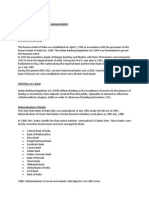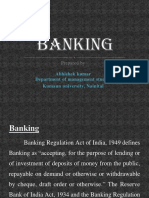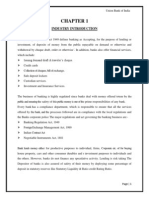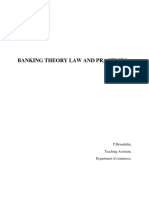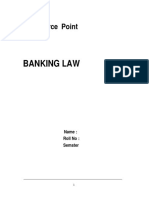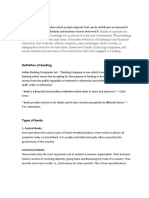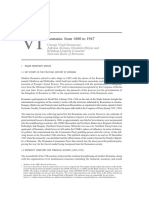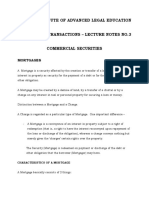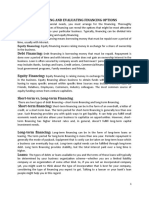Banking Companies
Banking Companies
Uploaded by
Sunanda SharmaCopyright:
Available Formats
Banking Companies
Banking Companies
Uploaded by
Sunanda SharmaOriginal Description:
Original Title
Copyright
Available Formats
Share this document
Did you find this document useful?
Is this content inappropriate?
Copyright:
Available Formats
Banking Companies
Banking Companies
Uploaded by
Sunanda SharmaCopyright:
Available Formats
CHAPTER 8
BANKING COMPANIES
Banks are vital to the prosperity and well-being of any society or country. Banks
enable a society to create the platform for the satisfaction of wants of its people
by managing and maintaining the flow of money to carry out transactions.
For smoothly meeting cash payment requirement, banks have to maintain Cash
Reserve Ratio (CRR) and Statutory Liquidity Ratio (SLR).
The capital adequacy norms given in this unit are as per existing Basel II norms. The
RBI requires Banks to maintain minimum capital risk adequacy ratio at prescribed
rate on an ongoing basis.
Capital is divided into two tiers according to the characteristics/qualities of each
qualifying instrument. Tier I capital consists mainly of share capital and disclosed
reserves and it is a bank’s highest quality capital because it is fully available to cover
losses. Tier II capital on the other hand consists of certain reserves and certain types
of subordinated debt.
The Banks have to classify their advances into two broad groups: 1. Performing
Assets; 2. Non-Performing Assets. These classification is done based on the
principle laid down by the RBI in Income Recognition and Asset Classification(IRAC)
norms.
Performing assets are also called as Standard Assets. The Non-Performing Assets
is again classified into three groups and they are (i) sub-standard Assets (ii)
doubtful assets & (iii) Loss Assets.
The banks have to maintain provisioning for Non-Performing Assets at the
prescribed rates. A banking company also performs Discounting of bills; Collection
of bills and Acceptances on behalf of customers
While preparing financial statements, banks have to follow various guidelines /
directions given by RBI/Government of India governing the Financial Statements.
The chapter has been divided into 6 units for the purpose of convenience in
understanding of the topic.
© The Institute of Chartered Accountants of India
8.2 ADVANCED ACCOUNTING
UNIT 1 : SOME RELEVANT PROVISIONS OF
THE BANKING REGULATIONS
ACT, 1949
LEARNING OUTCOMES
After studying this unit, you will be able to:
Understand the legal definition of banking, the composition of
management team of a bank and types of banks operating in
India.
Learn the conditions to be fulfilled for obtaining a license for
banking activities in India.
Learn the provisions relating to capital, reserve, liquidity norm
(Capital Reserve Ratio & Statutory Liquidity Ratio), reserve fund,
dividend payment and disposal of non-banking assets.
Try to relate such provisions with the financial information
obtained from any banking companies.
© The Institute of Chartered Accountants of India
BANKING COMPANIES 8.3
1.1 MEANING OF BANKING
Banks are vital to the prosperity and well-being of any society or country. Banks
enable a society to create the platform for the satisfaction of wants of its people
by managing and maintaining the flow of money to carry out transactions. The role
of banks may be likened to the heart in a human being, circulating and managing
money through the economy, thereby playing a crucial role for its good health.
Banks in India and their activities are regulated by the Banking Regulation Act,
1949.
Banking: Under Section 5(b) of the said Act “Banking” means,
Accepting deposits of money from public for the purpose of lending or
investing
These deposits are repayable on demand or otherwise, and can be withdrawn
by cheque, draft or otherwise.
Banking Company: Any bank which transacts this business as stated in section 5
(b) of the act in India is called a banking company. However merely accepting public
deposits by a company for financing its own business shall not make it a bank. It
may be mentioned that the Banking Regulation Act, 1949 is not applicable to a
primary agricultural society, a co-operative land mortgage bank and any other co-
operative society.
1.1.1 Types of banks
There are two main categories of Commercial Bank in India namely:-
1. Scheduled Commercial Bank
2. Scheduled Co-operative Bank
Scheduled Commercial Banks are again divided into five types and the Scheduled
Co-operative Banks into two as given in the following chart.
© The Institute of Chartered Accountants of India
8.4 ADVANCED ACCOUNTING
Types of Bank
Scheduled Commercial Banks Scheduled Co-operative Bank
Nationalised Bank eg. BOB,
SBI* Scheduled State Co-
operative Bank
Development Bank eg.
NABARD, EXIM
Scheduled Urban Co-
operative Bank
Regional Rural Bank
(Gramin Bank)**
Foreign Banks e.g. CITI
Bank, BNP Paribas
Private Sector Bank e.g.
ICICI, Axis
Scheduled Banks in India constitute those banks which have been included in the
Second Schedule of Reserve Bank of India (RBI) Act, 1934. After May 1997 there
are no non-scheduled commercial banks existing in India. However, there are small
to tiny non-scheduled Urban Co-operative Banks also known as Nidhiond Schedule
ots of the country.
The banks included in this schedule list should fulfill following two conditions:
1. The paid up capital and reserves in aggregate should not be less than ` 5
lakhs.
2. Any activity of the bank will not adversely affect the interests of depositors.
The Reserve Bank includes a bank in this schedule if it fulfils certain other conditions
too.
© The Institute of Chartered Accountants of India
BANKING COMPANIES 8.5
The RBI as the Central Bank is the ‘Bank of Last Resort’ i.e. when other commercial
banks are in trouble RBI helps them out. The services provided by RBI to scheduled
commercial banks include the following:
(a) The purchase, sale, and re-discounting of certain bills of exchange, or
promissory notes.
(b) Purchase and sale of foreign exchange.
(c) Purchase, sale and re-discounting of foreign bills of exchange.
(d) Making of loans and advances to scheduled banks.
(e) Maintenance of accounts of the scheduled bank in its banking department
and issue department.
(f) Remittance of money between different branches of scheduled banks
through the offices, branches or agencies of Reserve Bank free of cost or at
nominal rates.
1.1.2 Banking Company Business
Section 6 of the Banking Regulation Act, 1949 specifies the forms of business in
which a banking company may engage. These are:
(i) borrowing, raising or taking up of money, lending or advancing of money
either upon or without security;
(ii) the drawing, making, accepting, discounting, buying, selling collecting and
dealing in bills of exchange, hoondees, promissory notes, coupons, drafts,
bills of lading, railway receipts, warrants, debentures, certificates, scrips and
other instruments, and securities whether transferable or negotiable or not;
(iii) the granting and issuing of letters of credit, traveller's cheques and circular
notes;
(iv) the buying, selling and dealing in bullion and species;
(v) the buying and selling of foreign exchange including foreign bank notes;
(vi) the acquiring, holding, issuing on commission, underwriting and dealing in
stock, funds, shares, debentures, debenture stock, bonds, obligations,
securities and investments of all kinds;
(vii) the purchasing and selling of bonds scrips or other forms of securities on
behalf of constituents or, others the negotiating of loans and advances;
© The Institute of Chartered Accountants of India
8.6 ADVANCED ACCOUNTING
(viii) the receiving of all kinds of bonds, scrips or valuables on deposit or for safe
custody or otherwise;
(ix) the providing of safe deposit vaults;
(x) the collecting and transmitting of money and securities;
(ix) acting as agents for any government or local authority or any other person
or persons; the carrying on of agency business of any description including
the clearing and forwarding of goods, giving of receipts and discharges and
otherwise acting as an attorney on behalf of customers, but excluding the
business of a managing agent of a company;
(x) contracting for public or private loans and negotiating and issuing the same;
(xi) the effecting, issuing, guaranteeing underwriting, participating in the
managing and carrying out of any issue public or private, of State, municipal
or other loans or of shares, stocks, debentures, debenture stock of any
company, corporation or association and the lending of money for the
purpose of any such issue.
(xii) carrying on and transacting every kind of guarantee and indemnity business.
(xiii) managing, selling and realising property which may come into the possession
of the banking company in satisfaction of its claims.
(xiv) acquiring and holding and generally dealing with any property or any right,
title or interest in such property which may form the security for any loans
and advances or which may be connected with any such security.
(xv) underwriting and executing trusts.
(xvi) undertaking the administration of estates as executor, trustee or otherwise;
(xvii) establishing and supporting or aiding in the establishment and support of
associations, institutions, funds, trusts and conveniences calculated to benefit
employees or employees of the company or the dependents or connections
of such persons; granting pensions and allowances and making payments
towards insurance; subscribing to or guaranteeing moneys for charitable or
benevolent objects or for any exhibition or for any public, general or useful
object.
(xviii)acquisition, construction, maintenance and alteration of any building and
works necessary or convenient for the purpose of the banking company.
© The Institute of Chartered Accountants of India
BANKING COMPANIES 8.7
(xix) selling, improving, managing, developing, or otherwise dealing with all or any
part of the property and rights of the company.
(xx) acquiring and undertaking whole or any part of the business of any person
or company, when such business is of a nature enumerated or described in
this subsection.
(xxi) doing all such other things as are incidental or conductive to the promotion
or advancement of the business of the banking company.
(xxii) any other form of business which the Central Government may; by notification
in the Official Gazette, specify as a form of business in which it is lawful for a
banking company to engage.
No banking company shall engage in any form of business other than those
referred to above.
To summarise all the above, the functions of Commercial Bank are:
Functions of a Commercial Bank
Some of the main functions of modern commercial banks are:
(a) Receiving of money on deposit and providing facilities to constituents for
payments by cheque.
(b) Dealing in securities on its own account and on account of customers.
(c) Lending of money by -
(i) making loans and advances,
(ii) purchasing or discounting of bills.
(d) Transferring money from place to place by -
(i) the issue of demand drafts, telegraphic transfers, traveller’s cheques,
etc.,
(ii) collection of bills.
(e) Issuing letters of credit.
(f) Safe custody of securities and valuables.
(g) Issuing guarantees.
(h) Acting as executors and trustees sometimes through subsidiary companies
formed for that purpose.
© The Institute of Chartered Accountants of India
8.8 ADVANCED ACCOUNTING
(i) Buying, selling and dealing in foreign exchange.
(j) Acting as managers for issue of capital by companies and performing functions
incidental thereto.
1.2 PROHIBITION OF TRADING (SECTION 8)
A banking company cannot directly or indirectly deal in the buying or selling or
bartering of goods except in connection with the realization of security given to or
held by it. However, it may engage in any trade, or buy, sell or barter goods in
connection with the bills of exchange received for collection or negotiation or with
such of its aforesaid business.
1.3 DISPOSAL OF NON-BANKING ASSETS
(SECTION 9)
A banking company in the course of its business may have to take possession of
certain asset charged in its favour on account of the failure of a borrower to repay
the loan. A banking company can only acquire immovable property for its own use.
However, other immovable properties acquired must be disposed off within seven
years from the date of acquisition. The Reserve Bank of India at its discretion can
extend this period not exceeding five years where it is satisfied that such extension
would be in the interests of the depositors of the banking company. Income/loss
from such an asset has to be shown separately in the profit and loss account of the
banking company. It must be noted that the banking company can retain
immovable property if it is meant for the banks own use. The bank need to make a
separate disclosure of such Non-Banking Asset in their Financial Statement.
1.4 MANAGEMENT (SECTION 10)
Management of a Bank comes under its Board of Directors.
Under section 10A, not less than 51% of the total number of members of the board
of directors of a banking company shall consist of persons having special
knowledge or practical experience in one or more of the following fields:
1. Accountancy.
2. Agriculture and rural economy.
3. Banking.
© The Institute of Chartered Accountants of India
BANKING COMPANIES 8.9
4. Co-operation.
5. Economics.
6. Finance.
7. Law.
8. Small scale industry.
9. any other matter the special knowledge of, and practical experience in, which
would, in the opinion of the Reserve Bank, be useful to the banking company.
It is also required not less than two directors should have special knowledge or
practical experience in respect of agriculture and rural economy and co-operation
or small-scale industry.
Under section 10(b)(1), every banking company shall have one of its directors as
Chairman of its board of directors. The Chairman is entrusted with the management
of the whole of the affairs of the banking company. Such Chairman is the whole-
time employee of the banking company and can hold office for a period not
exceeding five years. Other directors who are whole-time directors can hold office
continuously for a period not exceeding eight years.
1.5 CAPITAL AND RESERVE
Requirement as to minimum paid-up capital and reserve (Section 11):
(1) No banking company in existence on the commencement of this Act, shall,
after the expiry of three years from such commencement or of such further period
not exceeding one year as the Reserve Bank, having regard to the interests of the
depositors of the company, may think fit in any particular case to allow, carry on
business in India, and no other banking company shall after the commencement of
this Act, commence or carry on business in India unless it complies with such of
the requirements of this section as are applicable to it.
(2) In the case of a banking company incorporated outside India-
(a) the aggregate value of its paid-up capital and reserves shall not be less than
fifteen lakhs of rupees and if it has a place or places of business in the city of
Bombay or Calcutta or both, twenty lakhs of rupees; and
(b) The banking company shall deposit and keep deposited with the Reserve
Bank either in cash or in the form of unencumbered approved securities,
or partly in cash and partly in the form of such securities-
© The Institute of Chartered Accountants of India
8.10 ADVANCED ACCOUNTING
(i) an amount which shall not be less than the minimum required by clause
(a); and
(ii) as soon as may be after the expiration of each year, an amount
calculated at twenty percent of its profit for that year in respect of all
business transacted through its branches in India, as disclosed in the
profit and loss account prepared with reference to that year under
section 29]
PROVIDED that any such banking company may at any time replace-
(i) any securities so deposited by cash or by any other unencumbered
approved securities or partly by cash and partly by other such securities,
so however, that the total amount deposited is not affected;
(ii) any cash so deposited by unencumbered approved securities of an
equal value.]
(3) In the case of any banking company to which the provisions of sub-section
(2) do not apply, the aggregate value of its paid-up capital and reserves shall not
be less than-
(i) if it has places of business in more than one State, five lakhs of rupees, and if
any such place or places of business is or are situated in the city of Bombay
or Calcutta or both, ten lakhs of rupees;
(ii) if it has all its places of business in one State none of which is situated in the
city of Bombay or Calcutta, one lakh of rupees in respect of its principal place
of business, plus ten thousand rupees in respect of each of its other places
of business situated in the same district in which it has its principal place of
business, plus twenty-five thousand rupees in respect of each place of
business situated elsewhere in the State otherwise than in the same district.an
aggregate value of fifty thousand rupees.
(iii) if it has all its places of business in one State, one or more of which is or are
situated in the city of Bombay or Calcutta, five lakhs of rupees, plus twenty-
five thousand rupees in respect of each place of business situated outside
the city of Bombay or Calcutta, as the case may be.
(4) Any amount deposited and kept deposited with the Reserve Bank by any
banking company incorporated [outside India] shall, in the event of the company
ceasing for any reason to carry on banking business [in India], be an asset of
© The Institute of Chartered Accountants of India
BANKING COMPANIES 8.11
the company on which the claims of all the creditors of the company [in India]
shall be a first charge.
Regulation relating to authorized capital, subscribed capital and paid-up
capital (Section 12): The subscribed capital of a banking company carrying on
business in India shall not be less than one-half of the authorised capital and the
paid-up capital shall not be less than one-half of the subscribed capital. The capital
of the banking company consists of ordinary shares only; or of ordinary shares or
equity shares and such preference shares which have been issued prior to the first
day of July, 1944. The voting right of any single shareholder on a poll cannot exceed
10% of the total voting rights.
Restriction on commission, brokerage, discount, etc., on sale of shares: Under
section 13 of the Banking Regulation Act, 1949, a banking company cannot pay out
directly or indirectly commission, brokerage, discount, or remuneration in respect
of any shares issued by it, an amount exceeding two and one-half per cent of the
paid-up value of such shares.
1.6 RESERVE FUNDS (SECTION 17)
Every banking company incorporated in India is required to create a Reserve Fund
and to transfer at least 20% of its profit to the reserve fund. The profit of the
year as per the profit and loss account prepared under Section 29 is to be taken as
base for the purpose of such transfer and transfer to reserve fund should be made
before declaration of any dividend.
If any banking company makes any appropriation from the reserve fund or share
premium account, it has to report to the Reserve Bank of India the reasons for such
appropriation within 21 days.
1.7 RESTRICTION AS TO PAYMENT OF DIVIDEND
(SECTION 15)
Before paying any dividend, a banking company has to write off completely all its
capitalised expenses including preliminary expenses, organisation expenses, share-
selling commission, brokerage, and amounts of losses incurred by tangible assets.
However, a banking company may pay dividend on its shares without writing off -
1. the depreciation in the value of its investment in approved securities in any
case where such depreciation has not actually been capitalised or accounted
for as a loss.
© The Institute of Chartered Accountants of India
8.12 ADVANCED ACCOUNTING
2. the depreciation in the value of its investment in shares, debentures or bonds
(other than approved securities) in any case where adequate provision for
such depreciation has been made to the satisfaction of the auditor of the
banking company.
3. the bad debts in any case where adequate provision for such debts had been
made to the satisfaction of the auditor of the banking company.
1.8 CASH RESERVE (SECTION 18)
For smoothly meeting cash payment requirement, banks have to maintain certain
minimum ready cash balances at all times. This is called as Cash Reserve Ratio (CRR)
Cash reserve can be maintained by way of either a cash reserve with itself or as
balance in a current account with the Reserve Bank of India or by way of net balance
in current accounts or in one or more of the aforesaid ways.
Every Scheduled Commercial Bank has to maintain cash reserve ratio (i.e. CRR) as
per direction of the RBI issued under Section 42(IA) of the Reserve Bank of India
Act, 1934.
The current Cash Reserve Ratio (CRR) is 4% of their Net Demand and Time Liabilities
(NDTL) with effect from the fortnight beginning February 09, 2013 vide circular
DBOD.No.Ret.BC.76 /12.01.001/2012-13 dated January 29, 2013. The Local Area
Banks shall also maintain CRR at 4.00 per cent of its net demand and time liabilities
from the fortnight beginning from February 09, 2013.
Demand and Time Liabilities
Demand Liabilities of a bank are liabilities which are payable on demand. These
include current deposits, demand liabilities portion of savings bank deposits,
margins held against letters of credit/guarantees, balances in overdue fixed
deposits, cash certificates and cumulative/recurring deposits, outstanding
Telegraphic Transfers (TTs), Mail Transfers (MTs), Demand Drafts (DDs), unclaimed
deposits, credit balances in the Cash Credit account and deposits held as security
for advances which are payable on demand. Money at Call and Short Notice from
outside the Banking System should be shown against liability to others.
Time Liabilities of a bank are those which are payable otherwise than on demand.
These include fixed deposits, cash certificates, cumulative and recurring deposits,
time liabilities portion of savings bank deposits, staff security deposits, margin held
© The Institute of Chartered Accountants of India
BANKING COMPANIES 8.13
against letters of credit, if not payable on demand, deposits held as securities for
advances which are not payable on demand and Gold deposits.
Other Demand and Time Liabilities (ODTL)
ODTL include interest accrued on deposits, bills payable, unpaid dividends,
suspense account balances representing amounts due to other banks or public, net
credit balances in branch adjustment account, any amounts due to the banking
system which are not in the nature of deposits or borrowing. Such liabilities may
arise due to items like (i) collection of bills on behalf of other banks, (ii) interest due
to other banks and so on. If a bank cannot segregate the liabilities to the banking
system, from the total of ODTL, the entire ODTL may be shown against item II (c)
'Other Demand and Time Liabilities' of the return in Form 'A' and average CRR
maintained on it by all SCBs.
Participation Certificates issued to other banks, the balances outstanding in the
blocked account pertaining to segregated outstanding credit entries for more than
5 years in inter-branch adjustment account, the margin money on bills purchased/
discounted and gold borrowed by banks from abroad, also should be included in
ODTL.
Cash collaterals received under collateralized derivative transactions should be
included in the bank’s DTL/NDTL for the purpose of reserve requirements as these
are in the nature of ‘outside liabilities’.
1.9 LICENSING OF BANKING COMPANIES
(SECTION 22)
A banking company can function in India only if it holds a licence issued by the
Reserve Bank of India and included in the Second Schedule of the RBI Act. Before
granting any licence, the Reserve Bank of India has to be satisfied that the specified
conditions have been complied:
Financial Requirement of:
Minimum capital requirement is to be complied with.
In addition to the financial requirement the Reserve Bank of India would need to
satisfy the other additional requirements:
(a) That the company is or will be in a position to pay its present or future
depositors in full as their claims accrue.
© The Institute of Chartered Accountants of India
8.14 ADVANCED ACCOUNTING
(b) That the affairs of the company are not being conducted or are not likely to
be conducted in a manner detrimental to the interest of its present or future
depositors.
(c) That the general character of the proposed management of the company will
not be prejudicial to the public interest or the interest of its depositors.
(d) That the company has adequate capital structure and earning prospects.
(e) That the public interest will be served by the grant of a licence to the company
to carry on banking business in India.
(f) That having regard to the banking facilities available in the proposed principal
area of operations of the company, the potential scope for expansion of
banks already in existence in the area and other relevant factors, the grant of
the licence would not be prejudicial to the operation and consolidation of the
banking system consistent with monetary stability and economic growth.
Similarly, prior permission of the Reserve Bank of India is necessary to open a new
branch of bank in India or to change the existing place of business situated in India.
Also, no banking company incorporated in India can open a branch outside India
or change the existing place of business without prior permission of the Reserve
Bank of India.
Provided that the provision mentioned in above paragraph shall not apply to the
opening for a period not exceeding one month of a temporary place of business
within a city, town or village or the environs thereof within which the banking
company already has a place of business, for the purpose of affording banking
facilities to the public on the occasion of an exhibition, a conference or a mela or
any other like occasion.
1.10 LIQUIDITY NORMS (SECTION 24)
Banking companies have to maintain sufficient liquid assets in the normal course
of business called as Statutory Liquidity Ratio (SLR). This safeguards the interest of
depositors and prevents banks from over-extending their resources, liquidity norms
have been settled and given statutory recognition. Every banking company has to
maintain the SLR in the form of:
1. cash
2. gold
3. unencumbered approved securities.
© The Institute of Chartered Accountants of India
BANKING COMPANIES 8.15
The above assets have to be held at the close of business on any day and shall be
valued at a price not exceeding the current market price of the above assets.
The percentage of SLR is changed by the Reserve Bank of India from time to time
considering the general economic conditions. This is in addition to the Cash
Reserve Ratio balance which a scheduled bank is required to maintain under
Section 42 of the Reserve Bank of India Act.
Maintenance of Statutory Liquidity Ratio (SLR)
In exercise of the powers conferred by sub-section (2A) of Section 24 read with
Section 51 and Section 56 of the Banking Regulation Act, 1949 (10 of 1949) and in
supersession of the notifications DBR.No.Ret.BC.14/12.02.001/2016-17 dated
October 13, 2016 BR.NDBR.No.Ret.BC.91/12.02.001/2017-18 dated October 04,
2017, the Reserve Bank hereby specifies that:
(i) 19.25 per cent from January 5, 2019
(ii) 19.00 per cent from April 13, 2019
(iii) 18.75 per cent from July 6, 2019
(iv) 18.50 per cent from October 12, 2019
(v) 18.25 per cent from January 4, 2020
(vi) 18.00 per cent from April 11, 2020
of their total net demand and time liabilities in India as on the last Friday of the
second preceding fortnight, valued in accordance with the method of valuation
specified by the Reserve Bank from time to time; and Such SLR assets shall be
maintained by Scheduled Commercial Banks (Including Regional Rural Banks), Local
Area Banks, Small Finance Banks and Payments Banks, as -
(a) cash; or
(b) gold as defined in Section 5(g) of the Banking Regulation Act, 1949 (10 of
1949) valued at a price not exceeding the current market price: or
(c) unencumbered investment in any of the following instruments [hereinafter
referred to as Statutory Liquidity Ratio securities (arket price: or Payments Ban
Dated securities of the Government of India issued from time to time under the
Market Borrowing Programme and the Market Stabilization Scheme ; or Treasury
Bills of the Government of India; or State Development Loans (SDLs) of the State
Governments issued from time to time under the market borrowing programme:
© The Institute of Chartered Accountants of India
8.16 ADVANCED ACCOUNTING
(d) the deposit and unencumbered approved securities required, under sub-
section (2) of section 11 of the Banking Regulation Act, 1949(10 of 1949), to be
made with the Reserve Bank by a banking company incorporated outside India;
(e) any balance maintained by a scheduled bank with the Reserve Bank in excess
of the balance required to be maintained by it under section 42 of the Reserve Bank
of India Act,1934 (2 of 1934);
Following securities shall not be treated as encumbered for the purpose of
maintenance of SLR assets, namely:-
(a) securities lodged with another institution for an advance or any other credit
arrangement to the extent to which such securities have not been drawn
against or availed of;
(b) securities offered as collateral to the Reserve Bank for availing liquidity
assistance under Marginal Standing Facility (MSF), up to the permissible
percentage of the total NDTL in India, carved out of the required SLR portfolio
of the bank concerned; and
(c) securities offered as collateral to the Reserve Bank for availing liquidity
assistance under Facility to Avail Liquidity for Liquidity Coverage Ratio
(FALLCR).
1.11 RESTRICTION ON ACQUISITION OF SHARES
IN OTHER COMPANY
A banking company cannot form any subsidiary except for one or more of the
following purposes:
1. The undertaking of any business permissible for banking company to
undertake.
2. Carrying on business of banking, exclusively outside India with previous
permission in writing, of the Reserve Bank.
3. The undertaking of such other business consider to be conducive to the
spread of banking in India or to be otherwise useful or necessary in the public
interest, which the Reserve Bank of India may permit with prior approval of
the Central Government.
Other than formation of such subsidiary companies as mentioned above, a banking
company cannot hold shares in any company either as pledge, mortgage, or absolute
© The Institute of Chartered Accountants of India
BANKING COMPANIES 8.17
owner of an amount not exceeding 30% of the paid-up share capital of that company
or 30% of its own paid-up share capital and reserves, whichever is less.
1.12 RESTRICTION ON LOANS AND ADVANCES
Under Section 20 of the Banking Regulations Act, a banking company shall not
grant any loans or advances on the security of its own shares. Further, it cannot
enter into any commitment for granting any loan or advance to or on behalf of -
(i) any of its directors.
(ii) any firm in which any of its directors is interested as partner, manager,
employee or guarantor.
(iii) any company other than the subsidiary of the banking company, or a
company which is entitled to dispense with the use of the word Ltd in its
name under the Companies Act, or a Government company of which any of
the directors of the banking company is a director, manager, employee or
guarantor or in which he holds substantial interest.
(iv) any individual in respect of whom any of its directors is a partner or a
guarantor.
1.13 PROHIBITION OF CHARGE ON UNPAID
CAPITAL AND FLOATING CHARGE ON
ASSETS
Under Section 14 of the Banking Regulation Act, no banking company shall create
any charge upon any unpaid capital of the company, and any charge if created shall
be invalid. A banking company also cannot create a floating charge on the
undertaking or any property of the company or any part thereof unless the creation
of such floating charge is certified in writing by the Reserve Bank as not being
detrimental to the interest of the depositors of such company (Section 14A). Any
charge created without obtaining the certificate from the RBI as above shall be
invalid (Sec 14 A (2)).
1.14 UNCLAIMED DEPOSITS
Under Section 26 of the Banking Regulations Act, every banking company is
required to submit a return in the prescribed form and manner, to the Reserve Bank
of India at the end of each calendar year, of all accounts in India which have not
© The Institute of Chartered Accountants of India
8.18 ADVANCED ACCOUNTING
been operated for 10 years. This report is to be submitted within 30 days after the
close of each calendar year. In case of fixed deposit, such 10 years are to be
reckoned from the date of expiry of the fixed deposit period.
Under Section 26A of the Banking Regulation Act, the Reserve Bank of India has
established a Fund to be called the "Depositor Education and Awareness Fund”. Every
Banking Company needs to credit to the Fund the amount to the credit of any account
in India with a banking company which has not been operated upon for a period of
ten years or any deposit or any amount remaining unclaimed for more than ten years,
within a period of three months from the expiry of the said period of ten years.
1.15 ACCOUNTS
At the end of each calendar year or at the expiration of twelve months ending on such
date as the Central Government may specify in this regard, every banking company
incorporated in India, in respect of business transacted by it, and every banking
company incorporated outside India, in respect of business transacted by its branches
in India, shall prepare with reference to that year or period, a Balance Sheet (Form A)
and Profit and Loss Account (Form B) as on the last working day of that year or the
period in the forms set out in the Third Schedule of Banking Regulation Act.
The Balance Sheet and the Profit and Loss Account must be signed by the manager
or principal officer and by at least three directors or all directors if there are not
more than three directors in case of a banking company incorporated in India. In
case of a banking company incorporated outside India, the statement of accounts
must be signed by the manager or agent of the principal office of the company in
India. In addition to the above, the Reserve Bank of India has also issued Master
Circular on Disclosures to be made in the Financial Statement of these Companies.
1.16 RESOLUTION OF STRESSED ASSETS
(SECTION 35AA AND 35AB)
In light of recent significant increase in the Non-Performing Assets, the Banking
Regulation Act,1949 has been amended to give power to the Reserve Bank of India
to issue directions to any banking company or banking companies to initiate
insolvency resolution process in respect of a default, under the provisions of the
Insolvency and Bankruptcy Code, 2016.
Further, the Reserve Bank may, from time to time, issue directions to any banking
company or banking companies for resolution of stressed assets.
© The Institute of Chartered Accountants of India
You might also like
- Kerpa Singh V Bariam SinghDocument2 pagesKerpa Singh V Bariam SinghBotaz Chin100% (2)
- 38658bos28174 Mod3 c6Document133 pages38658bos28174 Mod3 c6Akash BabuNo ratings yet
- Accounting of Banking CompaniesDocument118 pagesAccounting of Banking CompaniesRohit ShawNo ratings yet
- 6-Banking CompaniesDocument134 pages6-Banking CompaniesAnilNo ratings yet
- Financial Statements of Banking CompaniesDocument122 pagesFinancial Statements of Banking CompaniesBiswajit PaulNo ratings yet
- 20004ipcc Paper5 Cp6.CrackedDocument122 pages20004ipcc Paper5 Cp6.CrackedNitteshdas ChatergiNo ratings yet
- Banking: Dr. Vivek SharmaDocument13 pagesBanking: Dr. Vivek Sharmaviveksharma51No ratings yet
- Symbi Banking Lecture Notes 2012Document29 pagesSymbi Banking Lecture Notes 2012Ankur ChauhanNo ratings yet
- Symbi Banking Lecture Notes 2012Document29 pagesSymbi Banking Lecture Notes 2012Abhijit DeshpandeNo ratings yet
- Chapter - 1 Introduction of Banking SectorDocument50 pagesChapter - 1 Introduction of Banking SectorGLOBAL INFO-TECH KUMBAKONAMNo ratings yet
- Symbi Banking Lecture NotesDocument21 pagesSymbi Banking Lecture NotesPankaj GahlawatNo ratings yet
- Retail Banking NotesDocument25 pagesRetail Banking NotesTarun MaheshwariNo ratings yet
- Abhishek Kumar Department of Management Studies Kumaun University, NainitalDocument69 pagesAbhishek Kumar Department of Management Studies Kumaun University, NainitalAarav AroraNo ratings yet
- Banking and Non Banking Financial InstitutionsDocument28 pagesBanking and Non Banking Financial Institutionsmamta jainNo ratings yet
- 180 Sample-Chapter PDFDocument15 pages180 Sample-Chapter PDFhanumanthaiahgowdaNo ratings yet
- Union Bank of India PDFDocument58 pagesUnion Bank of India PDFashwin thakurNo ratings yet
- Banking LawDocument47 pagesBanking LawTanya SinghNo ratings yet
- BII Final NOTES UNIT1Document26 pagesBII Final NOTES UNIT1SOHAIL makandarNo ratings yet
- All About BankingDocument31 pagesAll About BankinggoyaltarunNo ratings yet
- Module - 1 Bank and Banking: Merchant Banking & Financial ServicesDocument81 pagesModule - 1 Bank and Banking: Merchant Banking & Financial ServicesPrathima GirishNo ratings yet
- Banking Law and Practice Units-2Document52 pagesBanking Law and Practice Units-2പേരില്ലോക്കെ എന്തിരിക്കുന്നുNo ratings yet
- Union Bank of IndiaDocument58 pagesUnion Bank of Indiadivyesh_variaNo ratings yet
- Financial Intermediation BusinessDocument96 pagesFinancial Intermediation BusinessRoba AbeyuNo ratings yet
- PPTs On Definition, Structure and Function of Banking Laws Unit - 1Document23 pagesPPTs On Definition, Structure and Function of Banking Laws Unit - 1Ravi saxenaNo ratings yet
- Final Accounts of Banking Company - Lecture 01 - 21-08-2020Document8 pagesFinal Accounts of Banking Company - Lecture 01 - 21-08-2020akash gautamNo ratings yet
- Banking GEDocument16 pagesBanking GEkhairulb721No ratings yet
- Banking Regulation Act 1949 - ADocument24 pagesBanking Regulation Act 1949 - Asamyak jadhavNo ratings yet
- Final Accounts of Banking CompaniesDocument78 pagesFinal Accounts of Banking Companiespushkar73% (26)
- Banking Regulation Act, 1949Document11 pagesBanking Regulation Act, 1949rishiparkashNo ratings yet
- NBFC Module 2 CompletedDocument27 pagesNBFC Module 2 CompletedAneesha AkhilNo ratings yet
- Banking Regulation Act 1949..Document12 pagesBanking Regulation Act 1949..sheetallunthi79No ratings yet
- Banking IntroductionDocument11 pagesBanking IntroductionrishiparkashNo ratings yet
- Banking Theory Law and PracticesDocument67 pagesBanking Theory Law and PracticesJESUINE J BBAENo ratings yet
- Audit of BanksDocument58 pagesAudit of Banksduck786No ratings yet
- Innovation in Banking and Insurance 2010Document130 pagesInnovation in Banking and Insurance 2010Bindi KapadiaNo ratings yet
- Banking OverviewDocument46 pagesBanking OverviewnisseemkNo ratings yet
- Banking LawDocument149 pagesBanking LawJagriti SaikiaNo ratings yet
- Audit of BanksDocument36 pagesAudit of BanksgauravNo ratings yet
- Unit-2 Notes Financial Market Chinmay MamDocument28 pagesUnit-2 Notes Financial Market Chinmay Mamvivek singhNo ratings yet
- Unit Four (2) (1) .Document26 pagesUnit Four (2) (1) .Neetu PrasadNo ratings yet
- Ca Foundation: Introducing Best Faculties Together at One Platform (COC Education) ForDocument43 pagesCa Foundation: Introducing Best Faculties Together at One Platform (COC Education) ForTarunNo ratings yet
- Block 5Document123 pagesBlock 5Shreya PansariNo ratings yet
- Union Bank of IndiaDocument58 pagesUnion Bank of IndiaRakesh Prabhakar ShrivastavaNo ratings yet
- RRBDocument27 pagesRRBajaikg07No ratings yet
- BANKING AND INSURANCE COMPLETE NOTESDocument109 pagesBANKING AND INSURANCE COMPLETE NOTESYusuf AhmedNo ratings yet
- Module 1.1Document12 pagesModule 1.1meet daftaryNo ratings yet
- Commercial BankingDocument36 pagesCommercial Bankingkhatiwada2005No ratings yet
- Final Accounts of Banking CompaniesDocument28 pagesFinal Accounts of Banking CompaniesAmit_Agarwal_7219No ratings yet
- Banking Activities in IndiaDocument10 pagesBanking Activities in Indiaakankshabhardwaj111No ratings yet
- Major Functions of BanksDocument11 pagesMajor Functions of BanksDipti SinghNo ratings yet
- UNIT 1 Banking XIDocument15 pagesUNIT 1 Banking XIclass 11 ip guruNo ratings yet
- Financial Services & Institutions - An IntroductionDocument11 pagesFinancial Services & Institutions - An IntroductionMayank KumarNo ratings yet
- Session 2Document117 pagesSession 2Haritika ChhatwalNo ratings yet
- Banking Financial Services Management - Unit 1: Overview of Indian Banking SystemDocument64 pagesBanking Financial Services Management - Unit 1: Overview of Indian Banking SystemtkashvinNo ratings yet
- Universal Banking in IndiaDocument60 pagesUniversal Banking in IndiaPratik GosaviNo ratings yet
- Bank - Commercial BankDocument12 pagesBank - Commercial BankShalini Singh IPSANo ratings yet
- Law of Banking & NI ActDocument14 pagesLaw of Banking & NI Actikram4qaNo ratings yet
- Financial Performance of BankDocument14 pagesFinancial Performance of BankManjunath ShettyNo ratings yet
- Meaning of Banking: 1. Central BanksDocument6 pagesMeaning of Banking: 1. Central BanksMuskanNo ratings yet
- FInancial Management1 - PrelimDocument52 pagesFInancial Management1 - PrelimEscalante, Alliah S.No ratings yet
- VI.-ROMANIA (1) Emisiuni Bond-UriDocument48 pagesVI.-ROMANIA (1) Emisiuni Bond-Urimihai.t83No ratings yet
- LLP Full NotesDocument15 pagesLLP Full NotesJay Desai100% (1)
- Kendriya Vidyalaya Sangathan, Chennai Region: Model Paper AccountancyDocument12 pagesKendriya Vidyalaya Sangathan, Chennai Region: Model Paper AccountancyJoanna GarciaNo ratings yet
- Credit Appraisal ProcessDocument12 pagesCredit Appraisal ProcessmithilNo ratings yet
- Mythical Company Provided The Following Transactions:: University - Year 2 AccountingDocument2 pagesMythical Company Provided The Following Transactions:: University - Year 2 Accountingcollegestudent2000No ratings yet
- Mnitest Chapter 18Document2 pagesMnitest Chapter 18An DoNo ratings yet
- List of Non-Tax Deductible ExpensesDocument1 pageList of Non-Tax Deductible ExpensesNuqiah FathiahNo ratings yet
- Responsive Documents - CREW: Department of Education: Regarding For-Profit Education: 8/17/2011 - 11-00026 Ginns Responsive 8-12-11 - PART 1Document825 pagesResponsive Documents - CREW: Department of Education: Regarding For-Profit Education: 8/17/2011 - 11-00026 Ginns Responsive 8-12-11 - PART 1CREWNo ratings yet
- Davies RJN #4 Full Filing 03 14 2011Document60 pagesDavies RJN #4 Full Filing 03 14 2011j mcguireNo ratings yet
- Mortgage ReviewerDocument5 pagesMortgage ReviewerRosalia L. Completano LptNo ratings yet
- Personal Finance IncomeDocument83 pagesPersonal Finance Income35.អ៊ាន សមកិត្យាNo ratings yet
- WSM - Ziale - Commercial Law NotesDocument36 pagesWSM - Ziale - Commercial Law NotesElizabeth Chilufya100% (1)
- A Study On Comparative Analysis of Financial StatementDocument13 pagesA Study On Comparative Analysis of Financial StatementMehakNo ratings yet
- D 05 HistDocument51 pagesD 05 Histwilliamlord8No ratings yet
- Rudra Project Bba Sem-4 PDFDocument25 pagesRudra Project Bba Sem-4 PDFMVM world of statusNo ratings yet
- A Research Proposal On The Assessment of Credit Management System in Case of Abyssinia Bank Aksum BranchDocument42 pagesA Research Proposal On The Assessment of Credit Management System in Case of Abyssinia Bank Aksum BranchAmir sabir100% (2)
- Interest: Important TerminologyDocument4 pagesInterest: Important TerminologyArchit HingeNo ratings yet
- Researching Financing OptionsDocument2 pagesResearching Financing OptionsAbdulRehman100% (1)
- Abebech Tsige Laundry Soap Factory FinalDocument78 pagesAbebech Tsige Laundry Soap Factory Finalberhanu seyoumNo ratings yet
- Am No.00!8!10-Sc (Rehab Corporate)Document14 pagesAm No.00!8!10-Sc (Rehab Corporate)Jose BonifacioNo ratings yet
- Mindtree: Reference ModelDocument54 pagesMindtree: Reference ModelLiontiniNo ratings yet
- Bankruptcy Laws in PakistanDocument5 pagesBankruptcy Laws in PakistanUsman ZafarNo ratings yet
- Financial Ratios TableDocument2 pagesFinancial Ratios TableWiSeVirGoNo ratings yet
- The Davis Dynasty by John RothchildDocument8 pagesThe Davis Dynasty by John RothchildVladimir OlefirenkoNo ratings yet
- Case Study On Infrastructure FinanceDocument10 pagesCase Study On Infrastructure FinanceRatnadeep MitraNo ratings yet
- 1st Edition - NCLAT Judgement SummaryDocument29 pages1st Edition - NCLAT Judgement SummaryAarti singhNo ratings yet
- Innovation in Insurance 1Document75 pagesInnovation in Insurance 1Sandeep SinghNo ratings yet
- Financial EnvironmentDocument12 pagesFinancial Environmentsohail janNo ratings yet







